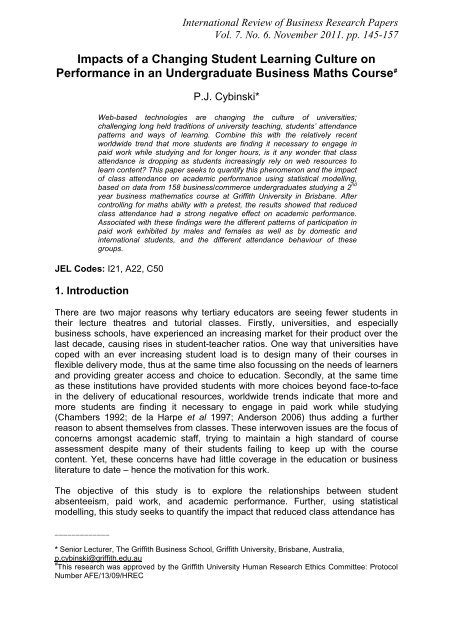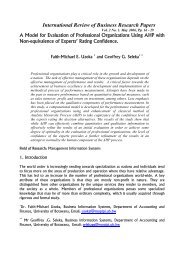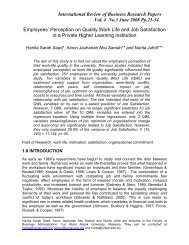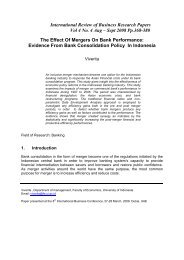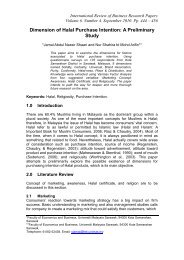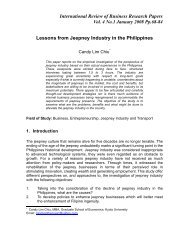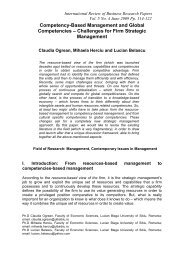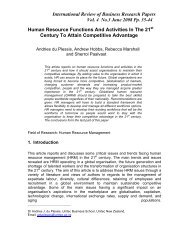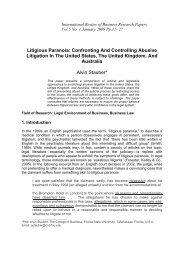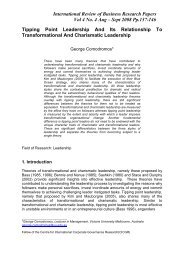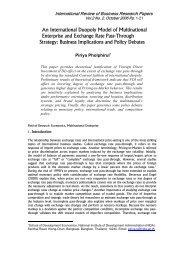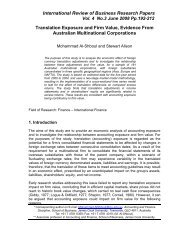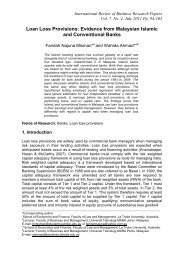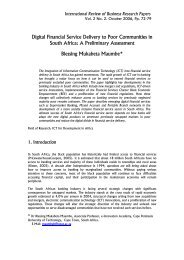Impacts of a Changing Student Learning Culture on Performance in ...
Impacts of a Changing Student Learning Culture on Performance in ...
Impacts of a Changing Student Learning Culture on Performance in ...
Create successful ePaper yourself
Turn your PDF publications into a flip-book with our unique Google optimized e-Paper software.
Cyb<strong>in</strong>ski<strong>on</strong> academic performance. It adds to the currently small body <str<strong>on</strong>g>of</str<strong>on</strong>g> research regard<strong>in</strong>gpaid work and student learn<strong>in</strong>g outcomes. It also br<strong>in</strong>gs gender differences <strong>in</strong>to themix as well as differences between <strong>in</strong>ternati<strong>on</strong>al student experiences and behavioursand those <str<strong>on</strong>g>of</str<strong>on</strong>g> domestic students –topics also little researched to date.In the next secti<strong>on</strong>, previous related literature is reviewed and summarized. Then theresearch methodology and data used are discussed. Empirical results found <strong>in</strong> thestudy are then presented and analyzed. Lastly, the c<strong>on</strong>clusi<strong>on</strong>s, implicati<strong>on</strong>s andlimitati<strong>on</strong>s <str<strong>on</strong>g>of</str<strong>on</strong>g> the study are discussed al<strong>on</strong>g with avenues for further research.2. Background and Literature Review2.1 Flexible <str<strong>on</strong>g>Learn<strong>in</strong>g</str<strong>on</strong>g> Practices„Flexible learn<strong>in</strong>g‟ with its switch <str<strong>on</strong>g>of</str<strong>on</strong>g> emphasis from teacher-centred to studentcentredlearn<strong>in</strong>g has been embraced at university level and <strong>in</strong>deed, most universities<strong>in</strong>clude flexible learn<strong>in</strong>g policies as prom<strong>in</strong>ent <strong>in</strong> their missi<strong>on</strong> statements. Researchregard<strong>in</strong>g the impact and effectiveness <str<strong>on</strong>g>of</str<strong>on</strong>g> technology-based and web-based delivery<str<strong>on</strong>g>of</str<strong>on</strong>g> educati<strong>on</strong> abounds (e.g. Laurillard 1993). The c<strong>on</strong>sensus is that new technologiescan be used to enhance student <strong>in</strong>dependence and c<strong>on</strong>trol over access to coursec<strong>on</strong>tent and other resources and can significantly reduce the required amount <str<strong>on</strong>g>of</str<strong>on</strong>g>formal face-to-face teach<strong>in</strong>g. However, not so much has been written about theimpact <str<strong>on</strong>g>of</str<strong>on</strong>g> these new learn<strong>in</strong>g envir<strong>on</strong>ments <strong>on</strong> students learn<strong>in</strong>g the <str<strong>on</strong>g>of</str<strong>on</strong>g>ten lesspopularquantitative courses <strong>in</strong> bus<strong>in</strong>ess degrees, like mathematics and statistics.There is some evidence that little face-to-face teach<strong>in</strong>g may not provide a qualitylearn<strong>in</strong>g envir<strong>on</strong>ment for these students and especially for those students with littleprior mathematics experience (Cyb<strong>in</strong>ski and Selvanathan 2005).2.2 Patterns <str<strong>on</strong>g>of</str<strong>on</strong>g> Participati<strong>on</strong> <strong>in</strong> Work and Tertiary StudyNeither have we seen much c<strong>on</strong>structive research <strong>on</strong> what has been termed “thenew millennium student” – <strong>on</strong>e who is work<strong>in</strong>g to study and study<strong>in</strong>g to work(Anders<strong>on</strong> 2006), and the effects <strong>on</strong> academic performance <str<strong>on</strong>g>of</str<strong>on</strong>g> add<strong>in</strong>g a substantialworkplace commitment to full-time study. The fact that commerce students are nowpay<strong>in</strong>g upwards <str<strong>on</strong>g>of</str<strong>on</strong>g> $8000 a year (<strong>in</strong> Australia) towards the cost <str<strong>on</strong>g>of</str<strong>on</strong>g> their tuiti<strong>on</strong>, hasmeant that many students are engaged <strong>in</strong> more hours <str<strong>on</strong>g>of</str<strong>on</strong>g> paid employment everyweek <strong>in</strong> order to fund their degrees than was the case a decade ago (McInnis et al2000). By 2002, 72.5% <str<strong>on</strong>g>of</str<strong>on</strong>g> Australian university students had paid employment dur<strong>in</strong>gsemester, work<strong>in</strong>g an average <str<strong>on</strong>g>of</str<strong>on</strong>g> 15 hours per week (McInnis and Hartley 2002) andby 2006, from a regi<strong>on</strong>al university study by Anders<strong>on</strong> (2006), that figure had<strong>in</strong>creased to 18 hours per week for a full-time student.Many are also mature-aged students, with <strong>on</strong>ly 27.2% aged under 20 (AustralianVice-Chancellors' Committee (AVCC) 2001, p.39). More importantly a nati<strong>on</strong>alsurvey <str<strong>on</strong>g>of</str<strong>on</strong>g> Australian student f<strong>in</strong>ances <strong>in</strong> 2006 showed that the number <str<strong>on</strong>g>of</str<strong>on</strong>g> studentswho claimed their paid work affected their studies had more than doubled from 16 to40 per cent s<strong>in</strong>ce 2000 (AVCC 2007). In the United States the Nati<strong>on</strong>al Centre forEducati<strong>on</strong>al Statistics (NCES) reported that am<strong>on</strong>g those undergraduates who<strong>in</strong>itially enrolled full time, the more hours they worked, the more likely they were toreduce their participati<strong>on</strong> to less than full-time enrolment or to stop attend<strong>in</strong>galtogether (NCES 1994). But <strong>in</strong> a later study <str<strong>on</strong>g>of</str<strong>on</strong>g> undergraduates who work, the146
Cyb<strong>in</strong>skiNCES (1996) reported that effects <strong>on</strong> outcomes were l<strong>in</strong>ked to a threshold number <str<strong>on</strong>g>of</str<strong>on</strong>g>hours worked per week - those work<strong>in</strong>g for more than 15 hours had significantlyhigher chances <str<strong>on</strong>g>of</str<strong>on</strong>g> dropp<strong>in</strong>g out <str<strong>on</strong>g>of</str<strong>on</strong>g> study than those who worked for less than 15hours per week.In Australia, l<strong>on</strong>gitud<strong>in</strong>al surveys by Vickers et al (2003) found that 44 per cent <str<strong>on</strong>g>of</str<strong>on</strong>g>male tertiary students do not work compared with <strong>on</strong>ly 36 per cent <str<strong>on</strong>g>of</str<strong>on</strong>g> females. Somore young women than young men sampled worked while they studied at tertiarylevel but males were more likely than females to work l<strong>on</strong>ger hours and a higherproporti<strong>on</strong> <str<strong>on</strong>g>of</str<strong>on</strong>g> males than females work <strong>on</strong> a full-time basis while they are study<strong>in</strong>g.The same study also found differences <strong>in</strong> the hours that n<strong>on</strong>-English speak<strong>in</strong>g (NES)and English speak<strong>in</strong>g (ES) full-time students worked part-time, with 50% <str<strong>on</strong>g>of</str<strong>on</strong>g> the NESgroup work<strong>in</strong>g, compared to 66% <str<strong>on</strong>g>of</str<strong>on</strong>g> the ES group. The statistics for students whowork more than 10 hours a week were 28% (NES) and 41% (ES). Research hasshown that paid work has both positive and negative impacts <strong>on</strong> student learn<strong>in</strong>g(e.g. McInnis et al 2000) but nevertheless, this „double commitment‟ means thatstudents are <str<strong>on</strong>g>of</str<strong>on</strong>g>ten no l<strong>on</strong>ger <strong>in</strong> a positi<strong>on</strong> to fully participate <strong>in</strong> the educati<strong>on</strong>alopportunities provided at their learn<strong>in</strong>g <strong>in</strong>stituti<strong>on</strong> to support their studies.So although educators are now teach<strong>in</strong>g to a larger enrolment, they are not see<strong>in</strong>gmost <str<strong>on</strong>g>of</str<strong>on</strong>g> their students <strong>in</strong> classes for the two reas<strong>on</strong>s cited above. The push forflexible learn<strong>in</strong>g has meant that educators are packag<strong>in</strong>g their courses <strong>on</strong>to the webfor students to access at will and thus entic<strong>in</strong>g many students, who already havemany compet<strong>in</strong>g demands <strong>on</strong> their time, to miss lectures and tutorials. Perhapsgreater accessibility to educati<strong>on</strong>al resources has given students a false sense <str<strong>on</strong>g>of</str<strong>on</strong>g>security <strong>in</strong> their studies so that they feel that physical engagement <strong>in</strong> their courses isno l<strong>on</strong>ger necessary.2.3 Class Attendance and Academic <strong>Performance</strong>The role <str<strong>on</strong>g>of</str<strong>on</strong>g> applicati<strong>on</strong> <strong>in</strong> relati<strong>on</strong> to academic performance research has l<strong>on</strong>g beenpresumed significant, and c<strong>on</strong>scientiousness has been called „a powerful predictor <str<strong>on</strong>g>of</str<strong>on</strong>g>academic performance‟ (Busato et al 1999; Furnham and Mitchell 2002, p.62).C<strong>on</strong>sequently it is important for tertiary educators to c<strong>on</strong>sider the implicati<strong>on</strong>s <str<strong>on</strong>g>of</str<strong>on</strong>g> an<strong>in</strong>creas<strong>in</strong>g trend for students to physically disengage from academic life <strong>on</strong> campus.But measur<strong>in</strong>g these c<strong>on</strong>cepts can be difficult, so attendance data is <str<strong>on</strong>g>of</str<strong>on</strong>g>ten used as aproxy measure for student engagement.Research has shown that student attendance positively and c<strong>on</strong>sistently correlatesto standardised achievement tests <strong>in</strong> the USA and the UK (Park and Kerr 1990;Romer 1993; Devadoss and Foltz 1996; Marburger 2001; Woodfield et al 2006;Chen and L<strong>in</strong> 2008; Westerman et al 2011; am<strong>on</strong>g others) and <strong>in</strong> Australia(Mass<strong>in</strong>gham and Herr<strong>in</strong>gt<strong>on</strong> 2006).If class attendance is, <strong>in</strong>deed, important for academic success then it would beuseful to analyse the major reas<strong>on</strong>s why students might be discouraged fromattend<strong>in</strong>g classes either by choice or by necessity. Therefore this study is unique <strong>in</strong>that it <strong>in</strong>vestigates the effect <str<strong>on</strong>g>of</str<strong>on</strong>g> paid employment <strong>on</strong> the level <str<strong>on</strong>g>of</str<strong>on</strong>g> student attendanceand whether there are different patterns <str<strong>on</strong>g>of</str<strong>on</strong>g> paid employment for foreign and domesticstudents and for males and females.147
Cyb<strong>in</strong>ski2.4 Numeracy and Academic <strong>Performance</strong>The importance <str<strong>on</strong>g>of</str<strong>on</strong>g> mathematical skills to student performance <strong>in</strong> many quantitativediscipl<strong>in</strong>es is widely recognised. Johns<strong>on</strong> and Kuennen (2006) found that a mathquizscore was significantly related to performance <strong>in</strong> an <strong>in</strong>troductory statisticscourse (as was student GPA and gender) and that this result was robust acrosscourse formats and <strong>in</strong>structors. Other studies have used the maths comp<strong>on</strong>ent <str<strong>on</strong>g>of</str<strong>on</strong>g> atertiary entrance score like the Scholastic Aptitude Test (SAT) or American CollegeTest (ACT) (e.g. Ely & Hittle 1990). It is important to c<strong>on</strong>trol for prior mathsexperience/knowledge <strong>in</strong> order to validly test the research questi<strong>on</strong>: whether classattendance provides any value–added to overall course performance.3. Data and Methodology3.1 The DataA short questi<strong>on</strong>naire <strong>in</strong>clud<strong>in</strong>g a basic numeracy pretest was adm<strong>in</strong>istered to allstudents attend<strong>in</strong>g the first lecture <str<strong>on</strong>g>of</str<strong>on</strong>g> the Quantitative Methods for Bus<strong>in</strong>ess, F<strong>in</strong>anceand Ec<strong>on</strong>omics course (hereafter termed „QM‟) <str<strong>on</strong>g>of</str<strong>on</strong>g>fered <strong>in</strong> 2007 with<strong>in</strong> the GriffithBus<strong>in</strong>ess School at Griffith University <strong>in</strong> Brisbane. This is a core course for majors <strong>in</strong>Bank<strong>in</strong>g and F<strong>in</strong>ance and <strong>in</strong> Ec<strong>on</strong>omics and an elective for many Account<strong>in</strong>g majors.The participant sample, termed the „resp<strong>on</strong>dent‟ group, <strong>in</strong>cluded all <str<strong>on</strong>g>of</str<strong>on</strong>g> the 158students who sat the pretest and who also provided their correct student i.d. <strong>on</strong> thequesti<strong>on</strong>naire/pretest that allowed a match<strong>in</strong>g <str<strong>on</strong>g>of</str<strong>on</strong>g> this data with their assessmentresults and tutorial attendance <strong>in</strong>formati<strong>on</strong>. The resp<strong>on</strong>dent group comprised 60% <str<strong>on</strong>g>of</str<strong>on</strong>g>the 262 students who completed the course.At the time data were collected for this study, lectures were delivered <strong>in</strong> thetraditi<strong>on</strong>al way via a large lecture theatre without any form <str<strong>on</strong>g>of</str<strong>on</strong>g> lecture capturecapability. Only the lecture notes were available <strong>on</strong> the web, prior to the lecture. Sothere was a small w<strong>in</strong>dow <str<strong>on</strong>g>of</str<strong>on</strong>g> opportunity to <strong>in</strong>vestigate students‟ engagement withthe course as measured by <strong>on</strong>-campus class attendance before lecture capture was<strong>in</strong>troduced to c<strong>on</strong>found the effect that attendance has <strong>on</strong> performance.3.2 Hypothesis DevelopmentThe ma<strong>in</strong> hypothesis (stated <strong>in</strong> the alternative form) that reflects the researchobjective given <strong>in</strong> the Introducti<strong>on</strong> is:H A : Reduced class attendance has a negative effect <strong>on</strong> academic performance.This paper seeks to test this hypothesis and quantify the effect that class attendancehas <strong>on</strong> academic performance by us<strong>in</strong>g multivariate statistical modell<strong>in</strong>g. Specificdetails <str<strong>on</strong>g>of</str<strong>on</strong>g> the variables <strong>in</strong>cluded and their measurement are listed below.Academic <strong>Performance</strong>/Achievement Overall ScoreIn practice, teach<strong>in</strong>g and learn<strong>in</strong>g effectiveness rema<strong>in</strong>s predom<strong>in</strong>antly determ<strong>in</strong>edby student performance <strong>in</strong> the recall and applicati<strong>on</strong> <str<strong>on</strong>g>of</str<strong>on</strong>g> learnt c<strong>on</strong>cepts and skills. Inthis study student performance is measured by the overall total score out <str<strong>on</strong>g>of</str<strong>on</strong>g> 100achieved <strong>on</strong> three closed-book exams: a mid-semester exam (20), a comput<strong>in</strong>gexam (20) and a f<strong>in</strong>al exam (60).148
Cyb<strong>in</strong>skiAttendanceThe QM course is normally taught <strong>in</strong> <strong>on</strong>e block, that is, <strong>on</strong> <strong>on</strong>e day <str<strong>on</strong>g>of</str<strong>on</strong>g> the week and,<strong>in</strong> 2007, with 8 tutorial groups each week that all met with<strong>in</strong> a few hours either beforeor after the two-hour lecture, scheduled <strong>in</strong> the early even<strong>in</strong>g. It is difficult to takeattendances at the lecture but students enrol <strong>in</strong> <strong>on</strong>e tutorial <str<strong>on</strong>g>of</str<strong>on</strong>g> typically 25-30students where tutors can more easily record <strong>in</strong>dividual attendances every week.There were 10 tutorial weeks so students received an attendance score out <str<strong>on</strong>g>of</str<strong>on</strong>g> 10.Whether attendance is recorded for lectures or tutorials/classes may, arguably, be <str<strong>on</strong>g>of</str<strong>on</strong>g>little importance for the general issue <str<strong>on</strong>g>of</str<strong>on</strong>g> performance, as Stanca (2006) noted thatboth have a similar effect <strong>on</strong> performance.Pretest ScoreThe maths pretest was used to measure the maths skills <str<strong>on</strong>g>of</str<strong>on</strong>g> the students before theybegan the course. It provides (1) student mathematical knowledge <strong>on</strong> a given daywithout any preparati<strong>on</strong> or study and (2) student knowledge <str<strong>on</strong>g>of</str<strong>on</strong>g> extremely basicmaterial, without the use <str<strong>on</strong>g>of</str<strong>on</strong>g> a calculator. The basic numeracy pretest c<strong>on</strong>sisted <str<strong>on</strong>g>of</str<strong>on</strong>g> 10questi<strong>on</strong>s to be answered <strong>in</strong> 20 m<strong>in</strong>utes at the first lecture. These were marked togive a total score out <str<strong>on</strong>g>of</str<strong>on</strong>g> 22. The maths quiz was orig<strong>in</strong>ally developed by the author,based <strong>on</strong> many years‟ experience teach<strong>in</strong>g remedial maths classes. The scoreachieved was c<strong>on</strong>verted to a percentage and used as a necessary c<strong>on</strong>trol variable <strong>in</strong>the statistical model that follows.GenderThere is very little <strong>in</strong>formati<strong>on</strong> <strong>in</strong> the literature relat<strong>in</strong>g to whether male and femaleundergraduate students have differential rates <str<strong>on</strong>g>of</str<strong>on</strong>g> attendance and whether any suchdifferences are related to their academic performance outcomes. Results from amajor study <strong>in</strong> the U.K. by Woodfield et al (2006) <str<strong>on</strong>g>of</str<strong>on</strong>g> 700 undergraduates at SussexUniversity and the factors affect<strong>in</strong>g their degree outcomes found differentialattendance rates between male and female students.ESL – Language and <str<strong>on</strong>g>Student</str<strong>on</strong>g> Cultural BackgroundAround the time <str<strong>on</strong>g>of</str<strong>on</strong>g> this study more than 9780 <strong>in</strong>ternati<strong>on</strong>al students made up 26.4per cent <str<strong>on</strong>g>of</str<strong>on</strong>g> the students <strong>on</strong> five Griffith campuses, represent<strong>in</strong>g 123 countries <str<strong>on</strong>g>of</str<strong>on</strong>g>orig<strong>in</strong>. <str<strong>on</strong>g>Student</str<strong>on</strong>g>s were asked for a b<strong>in</strong>ary resp<strong>on</strong>se that identified them as studentswith English as a sec<strong>on</strong>d language (ESL) or not (n<strong>on</strong>-ESL). S<strong>in</strong>ce the GriffithBus<strong>in</strong>ess School has the largest number <str<strong>on</strong>g>of</str<strong>on</strong>g> <strong>in</strong>ternati<strong>on</strong>al students <str<strong>on</strong>g>of</str<strong>on</strong>g> all thefaculties/schools, it is reas<strong>on</strong>able to assume that most <str<strong>on</strong>g>of</str<strong>on</strong>g> the ESL students are<strong>in</strong>ternati<strong>on</strong>al students. Under this assumpti<strong>on</strong> the resp<strong>on</strong>dent sample c<strong>on</strong>sisted <str<strong>on</strong>g>of</str<strong>on</strong>g>63% <strong>in</strong>ternati<strong>on</strong>al students and 37% domestic students.Paid Employment<str<strong>on</strong>g>Student</str<strong>on</strong>g>s were asked to record the average number <str<strong>on</strong>g>of</str<strong>on</strong>g> hours they worked <strong>in</strong> paidemployment <strong>in</strong> a typical semester week.3.3 Statistical AnalysesFirstly, descriptive statistics and bivariate analyses will be used to explore therelati<strong>on</strong>ships between the variables <str<strong>on</strong>g>of</str<strong>on</strong>g> <strong>in</strong>terest described above before carry<strong>in</strong>g out amultiple regressi<strong>on</strong> analysis to quantify the effects they may have <strong>on</strong> performance.Two-way <strong>in</strong>teracti<strong>on</strong> models and a ma<strong>in</strong> effects model will be estimated for academic149
Cyb<strong>in</strong>skiperformance us<strong>in</strong>g the GLM Univariate procedure with<strong>in</strong> the SPSS statisticalpackage.4. Analysis and ResultsAttendanceAttendance dropped <str<strong>on</strong>g>of</str<strong>on</strong>g>f <strong>in</strong> the first few weeks <str<strong>on</strong>g>of</str<strong>on</strong>g> the semester until about half wereattend<strong>in</strong>g each week. The median and the mean attendance were both 5 out <str<strong>on</strong>g>of</str<strong>on</strong>g> apossible 10 tutorials or 50% <str<strong>on</strong>g>of</str<strong>on</strong>g> the available sessi<strong>on</strong>s. Comparis<strong>on</strong>s with otherresearch here and abroad show vary<strong>in</strong>g results. Note that neither lecture nor tutorialattendance was compulsory for the course nor was any assessment weight<strong>in</strong>g givenfor participati<strong>on</strong> – a possible cause <str<strong>on</strong>g>of</str<strong>on</strong>g> bias <strong>in</strong> some studies that may have beenoverlooked or not reported. Mass<strong>in</strong>gham and Herr<strong>in</strong>gt<strong>on</strong> (2006) reported an 80%average attendance at tutorials but noted that students were required to attend 75%<str<strong>on</strong>g>of</str<strong>on</strong>g> tutorials or risk fail<strong>in</strong>g the subject. Other research gave the follow<strong>in</strong>g figures: -Rodgers and Rodgers (2003): 62% at lectures, 73% at tutorials; Rodgers (2001):68% at lectures, 80% at tutorials; and Romer (1993) reports that „attendance counts…<strong>in</strong>dicate usually about <strong>on</strong>e-third <str<strong>on</strong>g>of</str<strong>on</strong>g> students are not <strong>in</strong> class‟ [p.167].Attendance and Academic <strong>Performance</strong>The relati<strong>on</strong>ship between attendance and academic performance was a significant<strong>on</strong>e (p=0.001). Those students who engaged most with the course achievedsignificantly higher scores and the relati<strong>on</strong>ship is decidedly l<strong>in</strong>ear <strong>on</strong> a scatter plot.But are these students the same <strong>on</strong>es that have higher numeracy skills (mathsability), as evidenced by their pretest scores, or is attendance <strong>in</strong>deed a reas<strong>on</strong> forperform<strong>in</strong>g better academically? Multiple regressi<strong>on</strong> modell<strong>in</strong>g will be employed totest the relati<strong>on</strong>ship further.Gender and AttendanceSee Figure 1 display<strong>in</strong>g the separate boxplots for male and female attendancefigures.Figure 1: Box Plot* Attendance Distributi<strong>on</strong>s for Males and Females*Boxplots give a visual summary <str<strong>on</strong>g>of</str<strong>on</strong>g> the distributi<strong>on</strong>s show<strong>in</strong>g the median, upper and lower quartiles,and the m<strong>in</strong>imum and maximum observed values.150
Cyb<strong>in</strong>skiThe mean (median) attendance statistics (TuteAttendTotal/10) were 6 (7) out <str<strong>on</strong>g>of</str<strong>on</strong>g> apossible 10 tutorials for females and 4.5 (4) for males. This suggests that femalesare more engaged with the course than males and the difference <strong>in</strong> the means <str<strong>on</strong>g>of</str<strong>on</strong>g> 1.5tutorials is significant (p=0.002), especially s<strong>in</strong>ce the male distributi<strong>on</strong> is highlyskewed towards low attendances. This study therefore c<strong>on</strong>firms the differential rates<str<strong>on</strong>g>of</str<strong>on</strong>g> attendance by males and females found <strong>in</strong> the large UK study by Woodfield et al(2006).Numeracy/Pretest Score and Academic <strong>Performance</strong>Because pretest score was str<strong>on</strong>gly l<strong>in</strong>early related to overall performance (r=0.48,p
Cyb<strong>in</strong>skiFigure 2: Box Plot- Attendance Distributi<strong>on</strong>s for Different Levels <str<strong>on</strong>g>of</str<strong>on</strong>g>EmploymentPaid Employment and ESL; Attendance and ESLThe distributi<strong>on</strong> <str<strong>on</strong>g>of</str<strong>on</strong>g> hours <strong>in</strong> paid employment was very different for <strong>in</strong>ternati<strong>on</strong>al anddomestic students (See Figure 3). Domestic students (n<strong>on</strong>-ESL) were engaged <strong>in</strong>paid employment for significantly more hours than <strong>in</strong>ternati<strong>on</strong>al students (ESL) withmean/median values 22/20 compared to 8/0 (ESL) and this was reflected <strong>in</strong> theirsignificantly lower attendance rates(p
Cyb<strong>in</strong>skiFigure 4: Box Plot- Attendance Distributi<strong>on</strong>s for Internati<strong>on</strong>al (ESL) andDomestic (n<strong>on</strong>-ESL) <str<strong>on</strong>g>Student</str<strong>on</strong>g>sThis study therefore supports the f<strong>in</strong>d<strong>in</strong>gs from the l<strong>on</strong>gitud<strong>in</strong>al surveys by Vickers etal (2003) that English-speak<strong>in</strong>g full-time students <strong>in</strong> Australia work more and forl<strong>on</strong>ger hours than n<strong>on</strong>-English speak<strong>in</strong>g students. Whether this is a cultural issue orbecause <str<strong>on</strong>g>of</str<strong>on</strong>g> student visa requirements, given the ESL group are ma<strong>in</strong>ly <strong>in</strong>ternati<strong>on</strong>alstudents or for some other reas<strong>on</strong>, is bey<strong>on</strong>d the scope <str<strong>on</strong>g>of</str<strong>on</strong>g> this study and warrantsfurther research.Multiple Regressi<strong>on</strong> AnalysisThe correlati<strong>on</strong> analyses above have shown that overall performance <strong>in</strong> the coursewas significantly related to the numeracy pretest score (p
Cyb<strong>in</strong>skiThe <strong>in</strong>terpretati<strong>on</strong> <str<strong>on</strong>g>of</str<strong>on</strong>g> this model is that student performance is <strong>in</strong>creased, <strong>on</strong>average, by about 1 % for every extra tutorial attended out <str<strong>on</strong>g>of</str<strong>on</strong>g> a possible 10 and bynearly 0.4% for every extra 1% scored <strong>on</strong> a basic numeracy pre-test and femalesscore an extra 10.6 % over males.5. Discussi<strong>on</strong> and C<strong>on</strong>clusi<strong>on</strong>This study focuses <strong>on</strong> the determ<strong>in</strong>ants <str<strong>on</strong>g>of</str<strong>on</strong>g> success <strong>in</strong> a bus<strong>in</strong>ess mathematicscourse (ma<strong>in</strong>ly for students with majors <strong>in</strong> account<strong>in</strong>g, f<strong>in</strong>ance and ec<strong>on</strong>omics) us<strong>in</strong>gdata from 158 student resp<strong>on</strong>dents tak<strong>in</strong>g the course <strong>in</strong> the 1st semester <str<strong>on</strong>g>of</str<strong>on</strong>g> 2007.The explanatory variables studied and deemed important <strong>in</strong> the extant literature asdeterm<strong>in</strong>ants <str<strong>on</strong>g>of</str<strong>on</strong>g> student performance were: physical engagement <strong>in</strong> the course asmeasured by attendance; <strong>in</strong>nate numeric ability as measured by a pretest <str<strong>on</strong>g>of</str<strong>on</strong>g> basicmath skills; and gender. All showed a significant relati<strong>on</strong>ship with academicperformance. Most importantly, the ma<strong>in</strong> hypothesis <str<strong>on</strong>g>of</str<strong>on</strong>g> the study is supported: thatreduced class attendance has a negative effect <strong>on</strong> academic performance,specifically <strong>in</strong> quantitative courses with<strong>in</strong> a bus<strong>in</strong>ess/commerce degree.The effects <str<strong>on</strong>g>of</str<strong>on</strong>g> both English as a sec<strong>on</strong>d language (or <strong>in</strong>ternati<strong>on</strong>al/domestic status)and the level <str<strong>on</strong>g>of</str<strong>on</strong>g> paid employment that students were undertak<strong>in</strong>g each semesterweek were also important c<strong>on</strong>siderati<strong>on</strong>s for academic performance. But these weremost likely impact<strong>in</strong>g <strong>in</strong>directly <strong>on</strong> academic performance through their effects <strong>on</strong>attendance behaviour, s<strong>in</strong>ce domestic students were more likely to be engaged forl<strong>on</strong>ger hours <strong>in</strong> paid work than <strong>in</strong>ternati<strong>on</strong>al students and hence attended fewerclasses. Correlati<strong>on</strong>s between these variables were, <strong>in</strong>deed, significant and <strong>in</strong> theexpected directi<strong>on</strong>s.So the results support the view <str<strong>on</strong>g>of</str<strong>on</strong>g> other studies that attendance rates do matter <strong>in</strong>terms <str<strong>on</strong>g>of</str<strong>on</strong>g> course or f<strong>in</strong>al degree outcome (Romer 1993; Rau and Durand 2000;Woodfield et al 2006; Mass<strong>in</strong>gham and Herr<strong>in</strong>gt<strong>on</strong> 2006; am<strong>on</strong>g others). The resultsalso support the existence <str<strong>on</strong>g>of</str<strong>on</strong>g> differential attendance rates between male and femalestudents reported by Woodfield et al (2006) <strong>in</strong> the U.K. s<strong>in</strong>ce we found that femalesattended more classes and achieve significantly higher marks than their malecounterparts despite their equivalent level <str<strong>on</strong>g>of</str<strong>on</strong>g> numeracy skills com<strong>in</strong>g <strong>in</strong>to the course.The <strong>in</strong>ternati<strong>on</strong>al students (largely identified as hav<strong>in</strong>g English as a sec<strong>on</strong>dlanguage) were found to attend more classes and performed better overall thandomestic students and the evidence that the <strong>in</strong>ternati<strong>on</strong>al students also spent lesstime <strong>in</strong> paid work than the domestic students supports the f<strong>in</strong>d<strong>in</strong>gs <str<strong>on</strong>g>of</str<strong>on</strong>g> Vickers et al(2003). Similarly, females attended more classes, spent less time <strong>in</strong> paid work, andperformed better than males – as <strong>in</strong> the Vickers et al (2003) study.Numeracy skills, gauged here from a pretest score, were highly significant <strong>in</strong>predict<strong>in</strong>g course performance, as <strong>in</strong> other studies <str<strong>on</strong>g>of</str<strong>on</strong>g> quantitative courseperformance. This f<strong>in</strong>d<strong>in</strong>g has implicati<strong>on</strong>s for curriculum development, coursec<strong>on</strong>tent, and especially, course prerequisites. This has particular relevance to therecommendati<strong>on</strong>s <str<strong>on</strong>g>of</str<strong>on</strong>g> the Strategic Review <str<strong>on</strong>g>of</str<strong>on</strong>g> Mathematical Sciences Report from theUniversity <str<strong>on</strong>g>of</str<strong>on</strong>g> Melbourne (Rub<strong>in</strong>ste<strong>in</strong> and Hughes 2006) to encourage high schoolstudents to study higher maths and to reward them for do<strong>in</strong>g so with b<strong>on</strong>usmechanisms when comput<strong>in</strong>g tertiary entrance rank<strong>in</strong>gs. This f<strong>in</strong>d<strong>in</strong>g highlights theneed for university departments to <str<strong>on</strong>g>of</str<strong>on</strong>g>fer remedial maths courses or holiday (summer)maths courses for those with little high school maths.154
Cyb<strong>in</strong>skiAs usual with studies us<strong>in</strong>g resp<strong>on</strong>dent data, a limitati<strong>on</strong> <str<strong>on</strong>g>of</str<strong>on</strong>g> this study is that theresp<strong>on</strong>dents may not be fully representative <str<strong>on</strong>g>of</str<strong>on</strong>g> the whole group. S<strong>in</strong>ce approximately40% <str<strong>on</strong>g>of</str<strong>on</strong>g> the enrolled students did not attend the first lecture for the pretest numeracyquiz, the selectivity bias <strong>in</strong> our sample needs to be acknowledged. Are students whomiss the first lecture more likely to miss classes <strong>on</strong> a regular basis and so aresystematically different from the resp<strong>on</strong>dents with respect to the major predictor,attendance (Chan et al 1997)? Such a bias limits the power <str<strong>on</strong>g>of</str<strong>on</strong>g> the statistical testsand the generalizability <str<strong>on</strong>g>of</str<strong>on</strong>g> the study‟s c<strong>on</strong>clusi<strong>on</strong>s.As <strong>in</strong> all social science research, there is also the issue <str<strong>on</strong>g>of</str<strong>on</strong>g> completeness <str<strong>on</strong>g>of</str<strong>on</strong>g> themodel tested. Other variables or <strong>in</strong>teracti<strong>on</strong>s between variables that were omitteddue to an oversight <strong>in</strong> questi<strong>on</strong>naire design, measurement difficulties, or becausethey were bey<strong>on</strong>d the scope <str<strong>on</strong>g>of</str<strong>on</strong>g> the study may have c<strong>on</strong>tributed significantly to themodel and further improved its ability to predict or expla<strong>in</strong> academic performance.For <strong>in</strong>stance, further study <strong>in</strong>to the effects <str<strong>on</strong>g>of</str<strong>on</strong>g> other variables may be warranted andissues that have not been explored fully <strong>in</strong> the literature <strong>in</strong>clude those <str<strong>on</strong>g>of</str<strong>on</strong>g> timetabl<strong>in</strong>gand <strong>on</strong>-l<strong>in</strong>e resource availability.AcknowledgementsI would like to thank the participants and reviewers <str<strong>on</strong>g>of</str<strong>on</strong>g> the Eleventh Internati<strong>on</strong>alBus<strong>in</strong>ess Research C<strong>on</strong>ference held <strong>in</strong> Sydney, December 2-4, 2009, with thetheme:”Research for Change”. I value the enthusiastic resp<strong>on</strong>se I had to the paperand the c<strong>on</strong>structive comments and feedback I received.ReferencesAnders<strong>on</strong>, MJ 2006 „Degree <str<strong>on</strong>g>of</str<strong>on</strong>g> fit: university students <strong>in</strong> paid employment, servicedelivery and technology‟, Australasian Journal <str<strong>on</strong>g>of</str<strong>on</strong>g> Educati<strong>on</strong>al Technology,vol.22, no.1,pp. 88-103, viewed 20 March 2007,Australian Vice-Chancellors' Committee Report 2001, Key statistics <strong>on</strong> highereducati<strong>on</strong>.Australian Vice-Chancellors' Committee Report 2007, Australian university studentf<strong>in</strong>ances 2006; a summary <str<strong>on</strong>g>of</str<strong>on</strong>g> f<strong>in</strong>d<strong>in</strong>gs from a nati<strong>on</strong>al survey <str<strong>on</strong>g>of</str<strong>on</strong>g> students <strong>in</strong>public universities, Centre for the Study <str<strong>on</strong>g>of</str<strong>on</strong>g> Higher Educati<strong>on</strong>, The University <str<strong>on</strong>g>of</str<strong>on</strong>g>Melbourne, February, viewed 20 March 2007 Busato, VV, Pr<strong>in</strong>s, FJ, Elshout, JJ & Hamaker, C 1999, „The relati<strong>on</strong> betweenlearn<strong>in</strong>g styles, the Big Five pers<strong>on</strong>ality traits and achievement motivati<strong>on</strong> <strong>in</strong>higher educati<strong>on</strong>‟, Pers<strong>on</strong>ality and Individual Differences, vol. 26,pp.129-140.,no.10, pp. 1067-1073.Chambers, E 1992 „Work-load and the quality <str<strong>on</strong>g>of</str<strong>on</strong>g> student learn<strong>in</strong>g‟, Studies <strong>in</strong> HigherEducati<strong>on</strong>, vol.17, no.2, pp.141-153.Chan, K, Shum, C & Wright, D 1997, „Class attendance and student performance <strong>in</strong>pr<strong>in</strong>ciples <str<strong>on</strong>g>of</str<strong>on</strong>g> f<strong>in</strong>ance‟, F<strong>in</strong>ancial Practice and Educati<strong>on</strong>, vol.7, pp.58-65.Chen, J & L<strong>in</strong> TF 2008, „Class attendance and exam performance: A randomizedexperiment‟, Journal <str<strong>on</strong>g>of</str<strong>on</strong>g> Ec<strong>on</strong>omic Educati<strong>on</strong>, vol. 39 no. 3, pp. 213-227.155
Cyb<strong>in</strong>skiCyb<strong>in</strong>ski, PJ & Selvanathan, S 2005, „<str<strong>on</strong>g>Learn<strong>in</strong>g</str<strong>on</strong>g> experience and learn<strong>in</strong>geffectiveness <strong>in</strong> undergraduate statistics: modell<strong>in</strong>g performance <strong>in</strong> traditi<strong>on</strong>aland flexible learn<strong>in</strong>g envir<strong>on</strong>ments‟, The Decisi<strong>on</strong> Sciences Journal <str<strong>on</strong>g>of</str<strong>on</strong>g>Innovative Educati<strong>on</strong>, vol.3, no.2, pp. 251-271.Devadoss, S & Foltz, J 1996, „Evaluati<strong>on</strong> <str<strong>on</strong>g>of</str<strong>on</strong>g> factors <strong>in</strong>fluenc<strong>in</strong>g student classattendance and performance‟, American Journal <str<strong>on</strong>g>of</str<strong>on</strong>g> Agricultural Ec<strong>on</strong>omics, vol78, no.3, pp. 499-507.de la Harpe, B, Radl<str<strong>on</strong>g>of</str<strong>on</strong>g>f, A & Parker, L 1997, „Time spent work<strong>in</strong>g and study<strong>in</strong>g <strong>in</strong> thefirst year: what do students tell us?‟, <strong>in</strong> Pospisil, R & Willcoxs<strong>on</strong>, L (Eds.)<str<strong>on</strong>g>Learn<strong>in</strong>g</str<strong>on</strong>g> through Teach<strong>in</strong>g, pp.73-77. Proceed<strong>in</strong>gs <str<strong>on</strong>g>of</str<strong>on</strong>g> the 6 th Annual Teach<strong>in</strong>gand <str<strong>on</strong>g>Learn<strong>in</strong>g</str<strong>on</strong>g> Forum, Murdoch University, February 1997, viewed 20 March2007, Durden, GC & Ellis, LV 1995, „The effects <str<strong>on</strong>g>of</str<strong>on</strong>g> attendance <strong>on</strong> student learn<strong>in</strong>g <strong>in</strong>pr<strong>in</strong>ciples <str<strong>on</strong>g>of</str<strong>on</strong>g> ec<strong>on</strong>omics‟, American Ec<strong>on</strong>omic Review Papers and Proceed<strong>in</strong>gsvol. 85 (May), pp. 343–346.Ely, D & Hittle, L 1990, „The impact <str<strong>on</strong>g>of</str<strong>on</strong>g> math background <strong>on</strong> performance <strong>in</strong>managerial ec<strong>on</strong>omics and basic f<strong>in</strong>ance courses‟, Journal <str<strong>on</strong>g>of</str<strong>on</strong>g> F<strong>in</strong>ancialEducati<strong>on</strong>, vol.16, pp.59-61.Furnham, A & Mitchell, J 1991, ‟Pers<strong>on</strong>ality, needs, social skills and academicachievement: a l<strong>on</strong>gitud<strong>in</strong>al study‟, Pers<strong>on</strong>ality and Individual Differences, vol.12, no.10, pp. 1067-1073.Johns<strong>on</strong>, M & Kuennen, E 2006, „Basic math skills and performance <strong>in</strong> an<strong>in</strong>troductory statistics class‟, Journal <str<strong>on</strong>g>of</str<strong>on</strong>g> Statistics Educati<strong>on</strong>, vol.14,no.2, 25,viewed 17 October 2006,.Laurillard, D 1993, Reth<strong>in</strong>k<strong>in</strong>g University Teach<strong>in</strong>g: A framework for the effective use<str<strong>on</strong>g>of</str<strong>on</strong>g> educati<strong>on</strong>al technology, Routledge, L<strong>on</strong>d<strong>on</strong>.McInnis, C, James, R & Hartley, R 2000, Trends <strong>in</strong> the first year experience <strong>in</strong>Australian universities, Department <str<strong>on</strong>g>of</str<strong>on</strong>g> Educati<strong>on</strong>, Tra<strong>in</strong><strong>in</strong>g and Youth Affairs,Comm<strong>on</strong>wealth <str<strong>on</strong>g>of</str<strong>on</strong>g> Australia, Canberra, viewed 17 October 2006,McInnis, C & Hartley, R 2002, Manag<strong>in</strong>g study and work: the impact <str<strong>on</strong>g>of</str<strong>on</strong>g> full-time studyand paid work <strong>on</strong> the undergraduate experience <strong>in</strong> Australian universities,Department <str<strong>on</strong>g>of</str<strong>on</strong>g> Educati<strong>on</strong>, Science and Tra<strong>in</strong><strong>in</strong>g, Comm<strong>on</strong>wealth <str<strong>on</strong>g>of</str<strong>on</strong>g> Australia,Canberra.Marburger, DR 2001, „Absenteeism and undergraduate exam performance‟, Journal<str<strong>on</strong>g>of</str<strong>on</strong>g> Ec<strong>on</strong>omic Educati<strong>on</strong>, vol.32 (Spr<strong>in</strong>g), pp.99-109.Mass<strong>in</strong>gham, P & Herr<strong>in</strong>gt<strong>on</strong>, T 2006, „Does attendance matter? An exam<strong>in</strong>ati<strong>on</strong> <str<strong>on</strong>g>of</str<strong>on</strong>g>student attitudes, participati<strong>on</strong>, performance and attendance‟, Journal <str<strong>on</strong>g>of</str<strong>on</strong>g>University Teach<strong>in</strong>g and <str<strong>on</strong>g>Learn<strong>in</strong>g</str<strong>on</strong>g> Practice, vol.3, no.2, pp. 82-103, viewed 20March 2007, http://jutlp.uow.edu.auNati<strong>on</strong>al Centre for Educati<strong>on</strong>al Statistics (NCES) 1994, Undergraduates who workwhile enrolled <strong>in</strong> postsec<strong>on</strong>dary educati<strong>on</strong>: 1989-1990, NCES: Wash<strong>in</strong>gt<strong>on</strong>.Nati<strong>on</strong>al Centre for Educati<strong>on</strong>al Statistics (NCES) 1996 Undergraduates who work:nati<strong>on</strong>al postsec<strong>on</strong>dary student aid study, NCES: Wash<strong>in</strong>gt<strong>on</strong>.Park, KH & Kerr, P 1990, „Determ<strong>in</strong>ants <str<strong>on</strong>g>of</str<strong>on</strong>g> academic performance: a mult<strong>in</strong>omiallogit approach‟, Journal <str<strong>on</strong>g>of</str<strong>on</strong>g> Ec<strong>on</strong>omic Educati<strong>on</strong>, vol 21, no.2 (Spr<strong>in</strong>g), pp.101-111.Rau, W & Durand, A 2000, „The academic ethic and college grades: does hard workhelp students to „make the grade‟?‟, Sociology <str<strong>on</strong>g>of</str<strong>on</strong>g> Educati<strong>on</strong>, vol.73, no.1,pp.19-38.156
Cyb<strong>in</strong>skiRodgers, JR 2001, „A panel-data study <str<strong>on</strong>g>of</str<strong>on</strong>g> the effect <str<strong>on</strong>g>of</str<strong>on</strong>g> student attendance <strong>on</strong>university performance‟, Australian Journal <str<strong>on</strong>g>of</str<strong>on</strong>g> Educati<strong>on</strong>, vol. 45, no. 3, pp 284-295Rodgers, JL & Rodgers, JR 2003, „An <strong>in</strong>vestigati<strong>on</strong> <strong>in</strong>to the academic effectiveness<str<strong>on</strong>g>of</str<strong>on</strong>g> class attendance <strong>in</strong> an <strong>in</strong>termediary microec<strong>on</strong>omic theory class‟, Educati<strong>on</strong>Research and Perspectives, vol.30, No.1.Romer, D 1993, „Do students go to class? Should they?‟, The Journal <str<strong>on</strong>g>of</str<strong>on</strong>g> Ec<strong>on</strong>omicPerspectives, vol.7, no.3, pp.167-174.Rub<strong>in</strong>ste<strong>in</strong>, H & Hughes, B 2006, „Mathematics and statistics: critical skills forAustralia‟s future‟, Nati<strong>on</strong>al Strategic Review <str<strong>on</strong>g>of</str<strong>on</strong>g> Mathematical SciencesResearch Report, University <str<strong>on</strong>g>of</str<strong>on</strong>g> Melbourne, December, viewed 1 November2009, Stanca, L 2006, „The effects <str<strong>on</strong>g>of</str<strong>on</strong>g> attendance <strong>on</strong> academic performance: panel dataevidence for <strong>in</strong>troductory microec<strong>on</strong>omics‟, Journal <str<strong>on</strong>g>of</str<strong>on</strong>g> Ec<strong>on</strong>omic Educati<strong>on</strong>,vol.37 no. 3, pp.251-266.Vickers, N, Lamb, S & H<strong>in</strong>kley, J 2003, <str<strong>on</strong>g>Student</str<strong>on</strong>g> workers <strong>in</strong> high school and bey<strong>on</strong>d:the effects <str<strong>on</strong>g>of</str<strong>on</strong>g> part-time employment <strong>on</strong> participants <strong>in</strong> educati<strong>on</strong>, tra<strong>in</strong><strong>in</strong>g, andwork, (L<strong>on</strong>gitud<strong>in</strong>al Surveys <str<strong>on</strong>g>of</str<strong>on</strong>g> Australian Youth Research Report No. 30),Australian Council for Educati<strong>on</strong>al Research, Canberra, viewed 23 August2011Westerman, JW, Perez-Batres, LA, C<str<strong>on</strong>g>of</str<strong>on</strong>g>fey, BS & Pouder, RW 2011, „Therelati<strong>on</strong>ship between undergraduate attendance and performance revisited:alignment <str<strong>on</strong>g>of</str<strong>on</strong>g> student and <strong>in</strong>structor goals‟, Decisi<strong>on</strong> Sciences Journal <str<strong>on</strong>g>of</str<strong>on</strong>g>Innovative Educati<strong>on</strong>, vol. 9 no.1 (January), pp.49-67.Woodfield, R, Jessop, D & McMillan, L 2006, „Gender differences <strong>in</strong> undergraduateattendance rates‟, Studies <strong>in</strong> Higher Educati<strong>on</strong>, vol.31, no.1 (February), pp.1-22.157


